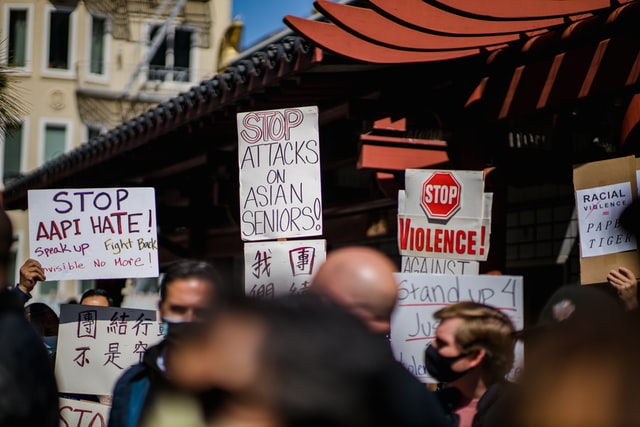
TWO instances of unprovoked attacks on elderly Asian women were featured on network TV in March — one in New York and the other incident, in San Francisco.
The New York attack was so brutal. I’ve only seen that kind of cruelty in movies, inflicted by Nazis on prisoners of war (POWs).
The 65-year-old Filipino woman, Vilma Kari, was walking on the sidewalk, in the vicinity of Times Square, when a big, burly man met her with a kick to the body. The poor woman fell on the pavement. The brute then kicked her thrice, before walking off.
The assailant was arrested the next day. He was on parole and had served time for killing his own mother.
The San Francisco anti-Asian attack, which was also unprovoked, frankly made me feel good. The intended victim, 76-year-old Xiao Zhen Xie, fought back with a piece of wood and maimed the assailant. The old woman suffered a swollen face, but the attacker — also big and burly like the New York brute — was in an even worse condition and had to be carried off in a stretcher by the police.
According to data compiled by the Center for the Study of Hate and Extremism of California State University, San Bernardino, hate crimes in the U.S. have decreased overall by 7%. But acts of violence committed against Asians have increased by almost 150%.
Yet, it could be a mistake to attribute all of these attacks to racism. Some may have been plain bullying or an intended robbery or hold-up. Asians may just seem more vulnerable, particularly the elderly.
When I sent my wife and four kids to the U.S. in 1986, racism was rampant in America. I was told that this was the case in Cambridge, on the Eastern Shore of Maryland, where my elder sister had a medical practice.
Our two youngest children, Jinx and Jojo, were the only Asians at Cambridge South Dorchester High School. Before my sister’s children went on to college, they were also the only Asians in that school. But our boys had no problem making friends, some of whom keep in touch to this day.
But one morning, as I prepared to drive to work in Makati, my wife called me long distance to inform me that Jinx had been suspended for getting into a fight in school.
Asked what had happened, Jinx explained that a classmate used a racial slur on him. “So I hit him!” Then he asked me quite candidly: “What would you have done, Papa?”
My response must have sounded awkward, coming from a father who wanted to properly raise his kids: “Well…I would have waited until after school.”
In truth, I felt conflicted. Gigi and I had endeavored to raise our children, according to the Boy Scout motto: Physically strong mentally alert, and morally straight. While the kids, all strived for good grades, they were also active in competitive sports. Jinx, Jojo and Christina, our only girl, had been members of the tae kwon do team at Colegio San Agustin in Makati. Ringo, the eldest, was a member of the swimming team at Don Bosco.
He was also taking judo lessons at YMCA.
Christina was the first of the children to study in the U.S., as a high school exchange student in Massachusetts. In one of her letters, she told us about a boy in the school bus who kept taunting her. Apparently, the boy had heard that she knew “some tae kwon do.”
Boasting that he was good in martial arts, he said he wanted to test Christina. She avoided the boy for as long as she could — but finally gave in one day.
She gave the boy a sound beating.
In another incident in Cambridge, three boys ganged up on Jinx outside of school. The next day, the news was all over the campus: “Hey, we heard you got beat by a guy named Jesus!”
Jinx’s full name is Jesus Federico.
Indeed, having lived in the U.S. for almost 35 years, my family and I have had a taste of racism, as well as bullying. But, frankly, I experienced more racism growing up in the land of my birth.
I spent my boyhood in Tacloban, Leyte, overlooking Cancabato Bay and the San Juanico Straits. To say that I was swarthy from frequent dips in the sea, would be an understatement. People actually used the “N” word on me.
In Tagalog movies, where I worked for many years, a common plot was a variation of the ugly duckling who — you guessed it — was always dark-skinned. Towards the end of the film, she would be magically transformed into a cream-complexioned Gloria Romero.
Former Makati Mayor, Vice President and presidential candidate, Jojo Binay, knows what I mean. Because he was leading early in the polls, pundits quipped that he could be “the first black president of the Philippines.”
However, VP Binay did not suffer from an “inferiority complexion.” During the presidential campaign, he actually made his swarthiness part of his “pang-masa” appeal. But, for good or ill, another non-Tisoy candidate won the presidency.
Sadly, we Filipinos have been so brainwashed in over 300 years of Spanish colonization, followed by decades under the influence of America and Hollywood. This could explain why most Pinoy men fantasize about a “white cover” girlfriend and why the women have made skin whiteners a hot-selling commodity.
Whether we are willing to admit it or not, Pinoys tend to regard those with darker skin as inferior. I understand that this attitude is also common in Latin America, a region of indios and mestizos.
In 1978, as I prepared for my first trip to the U.S. to attend the Advertising Age Creative Workshop in Chicago, Ruffin Grey, a friend from Clark Field, warned me about the dangers of walking around Chicago and downtown Los Angeles. It sounded like the advisory the State Department issues about going to Muslim Mindanao.
However, I enjoyed Chicago and Los Angeles without any incident. Well…almost. There was this drunken salesman at the bar of the Conrad Hilton in Chicago. He barked at me to vacate my seat at the bar, so he could take over.
Having had a few drinks myself, I snarled back at the fellow and told him I didn’t want to kill anyone on my birthday. I was bluffing, of course, although it really was my 38th birthday. The guy turned pale and backed off. We ended the evening buying drinks for each other.
Wolfgang Schoen, a client at Nestle Philippines, gave me an earful about dealing with people in strange places. A German with a fondness for beer and playing the piano, he frequented the honky-tonks in Culi-Culi in Makati, West of South Superhighway. Worried for his safety, I cautioned him about going to Culi-Culi, then notorious as a red light district.
“You don’t know your people enough,” said Wolfgang. “You should go with me sometime.”
I did join him in Culi-Culi and was amazed at how protective the bar girls and the “tambays” (street gangs) were of him.
“If you look for trouble,” Wolfgang lectured, “trouble will find you.”
Of course, the two elderly Asian women who were assaulted in New York and San Francisco were not looking for trouble. But trouble found them, nonetheless. And I’m afraid that they won’t be the last victims of anti-Asian violence in America. In fact, my eldest grandchild, Derick, who is active with the Asian American and Pacific Islander community, has been designated to organize a protest march against anti-Asian violence in San Francisco.
But I would still advise everyone to heed Wolfgang Schoen’s words as much as possible: “Don’t look for trouble or trouble will find you.”
The keywords are: “As much as possible.”
However, if it is not possible, my own advice is also from the Boy Scouts: “Be Prepared!”
* * *
The opinions, beliefs and viewpoints expressed by the author do not necessarily reflect the opinions, beliefs and viewpoints of the Asian Journal, its management, editorial board and staff.
* * *









